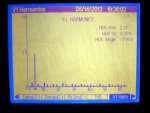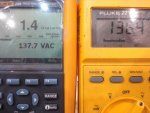130514-0825 EDT
High harmonic content does not imply a high crest factor, but it may.
Consider a square wave and a modification of it. I will illustrate with 3 variations. All have high harmonic content.
1. An exact square wave. +V volts for 1/2 period, and -V volts for the second 1/2 period. The RMS value is V, the average value is V, the reading on a Simpson 260 or Fluke 27 is V*0.707/0.636 = 1.111*V, and the crest factor is 1.0 .
2. Half of the square wave is removed. +V volts for 1/4 period, 0 for next 1/4 period, -V volts for next 1/4 period, and 0 for the last 1/4 period. By mental arithmetic the RMS value is 0.707*V, the average value is 0.5*V, Simpson 260 or Fluke 27 is 1.111*0.5*V = 0.555*V, and the crest factor for RMS is 1.0/0.707 = 1.414 . The same crest factor as a sine wave.
3. Three quarters of the square wave is removed. +V for 1/8 period, 0 for next 3/8 period, -V for 1/8 period, and 0 for the last 3/8 of the period. Again by mental arithmetic the RMS value is 0.5*V, the average value is 0.25*V, Simpson 260 or Fluke 27 is 1.111*0.25*V = 0.277*V, and the crest factor for RMS is 1.0/0.5 = 2.0 .
An electronic RMS measuring meter will have an amplifier or other device in the RMS conversion that will saturate or distort above some value. Call the saturation point Vs. Since many measurements are of sine waves it makes logical sense to design the meter so at full scale on a particular range that Vs is somewhat greater than 1.4 times Vrms full scale. Thus, 1.6 is probably a good choice for the meter design.
A meter of this design should read satisfactorily an RMS voltage that is 1/2 of full scale with a crest factor of 2*1.6 = 3.2 . Or if 1/4 of full scale then a crest factor of 6.4 .
A flat topped sine wave will have a crest factor somewhat less than 1.414 .
In the industrial world you will probably find virtually all commercial power sources with flat topped sine waves.
.






